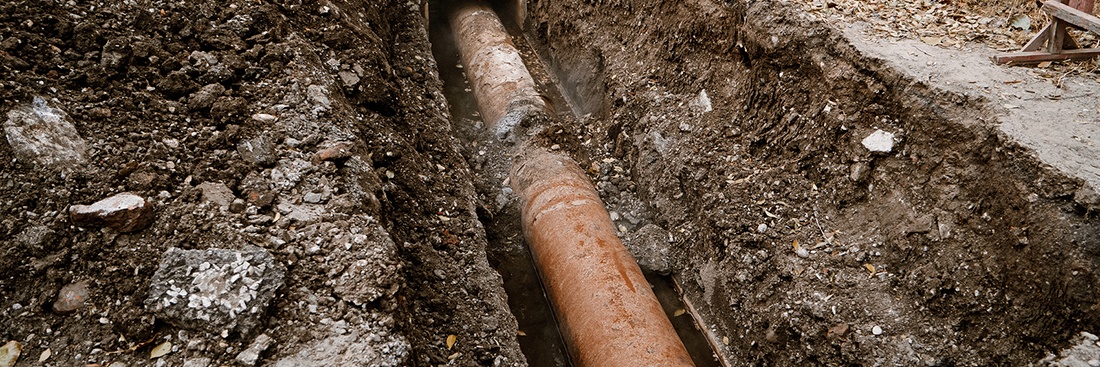
A sewer pipe repaired. New technology does exist that allows for complete pipe restoration using epoxy while doing minimal digging and pipe replacement.
Trenchless Sewer Repair
The traditional way to repair a broken sewer line is to dig a trench around the damaged pipe. This allows workers to remove and replace the pipe.
Trenchless sewer repair is a more appealing option for property owners of all kinds for several reasons:
- Less destruction. Trenchless sewer repair requires only one or two access points. As a result, there is minimal damage to gardens, lawns, tree roots, roads, and sidewalks.
- Less downtime. Trenchless repair is efficient. The affected section of the sewer system is back in service relatively quickly.
- Less disruption. Digging long and wide trenches requires more people and equipment. It can leave the area around the repair – including streets and sidewalks – off-limits for large periods of time.
- Lower restoration and rehabilitation costs. Because minimal landscaping (and sometimes property such as driveways) is destroyed, returning the area to be normal costs less in time and dollars.
There are two ways to repair sewer pipe without digging: lining and replacement. The type and extent of damage to the sewer pipe will influence which method should be used.
Unlike indoor plumbing repair where epoxy pipe lining is used, trenchless sewer repair uses sewer liners. Sewer pipe liners are flexible tubes (like a bicycle tire inner tube) treated with a resin that adheres to pipe material.
Reputable sewer lining companies like CuraFlo, assess the sewer line cost per foot of pipe to be repaired. Generally, relining sewer pipe costs less per foot than replacement but each situation is unique.
Trenchless Sewer Replacement
Inserting a new sewer lining isn’t possible when the pipe damage is severe or at a joint. In cases like that, trenchless sewer repair must be by replacement.
The no-dig sewer line replacement method involves two different but simultaneous steps. From the access point, a steel “bursting head” is inserted into the damaged pipe. Directly behind it is a new PVC (or other plastic) 4-inch sewer pipe.
Using specialized equipment, the plumbing technician forces the bursting head through the old pipe. This causes the pipe to break and move outward. The new pipe follows and immediately takes the place of the damaged pipe.
This method of no-dig sewer pipe repair works well for plastic, clay, and concrete pipes.
Cast Iron Sewer Pipe
Cast iron was first used for sewer pipes in North America during the 1800s. It continued to be used throughout the next century and beyond, although less frequently as the popularity of plastic pipe increased.
The strength of cast iron makes it nearly impossible to use the bursting method of sewer drain pipe repair.
Instead, no-dig sewer repair is done using a sewer pipe liner. From the access point and using specialized sewer lining equipment, a flexible sewer liner is inserted and pushed or pulled through the damaged pipe.
The same sewer pipe lining equipment is then used to inflate the pipe lining. Once pushed against the inside of the pipe, the sewer lining adheres to the cast iron.
It’s important to note that relining sewer pipe does not significantly reduce the inner diameter of the pipe. Yet, it can extend a cast iron sewer pipe life expectancy by 50 years.
Within 1-2 hours, the sewer line liner cures. When the sewer line lining is dry, a video inspection can confirm that the cast iron sewer pipe repair is complete.
Clay Sewer Pipe
Sewer lining is a good option for clay sewer pipes. The process for clay sewer pipe relining is the same as that for cast iron pipes except that a different resin is used.
Trenchless repair is especially ideal with clay pipes. Often tree roots are the cause of damage. By relining sewer pipe, there is minimal damage to tree roots and you extend the clay sewer pipe life expectancy by 50 years.
The team at CuraFlo has experience repairing all kinds of pipes using trenchless methods. Our process includes thorough video inspection of the damaged pipe to assess the damage and complete description of the steps that will restore your pipe to full working condition.
